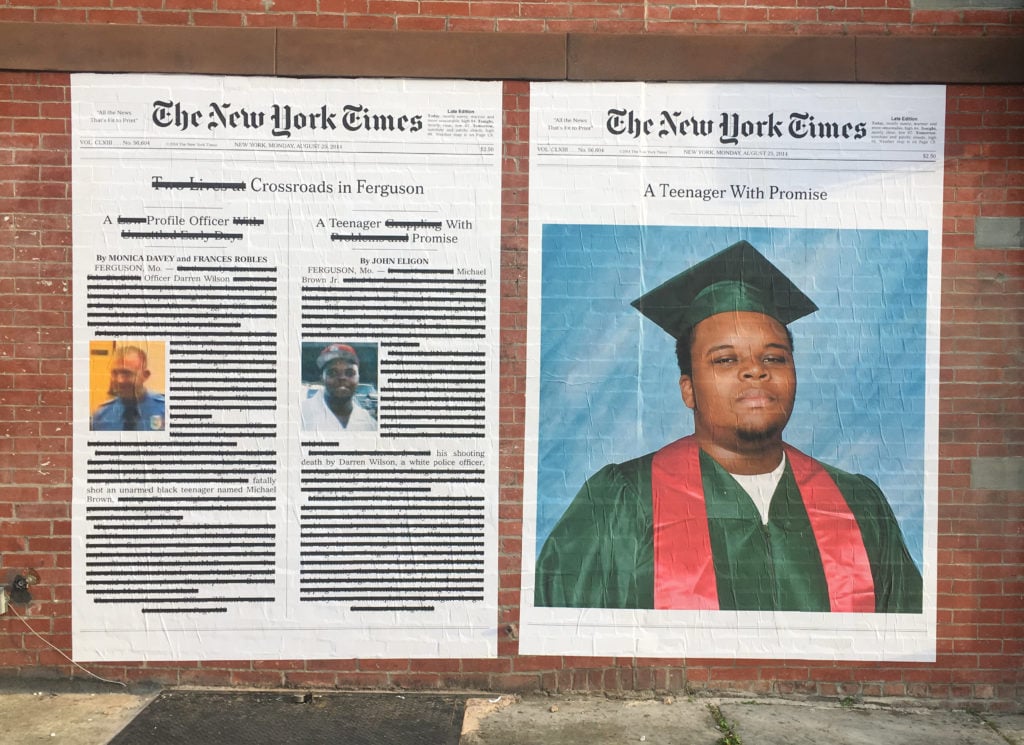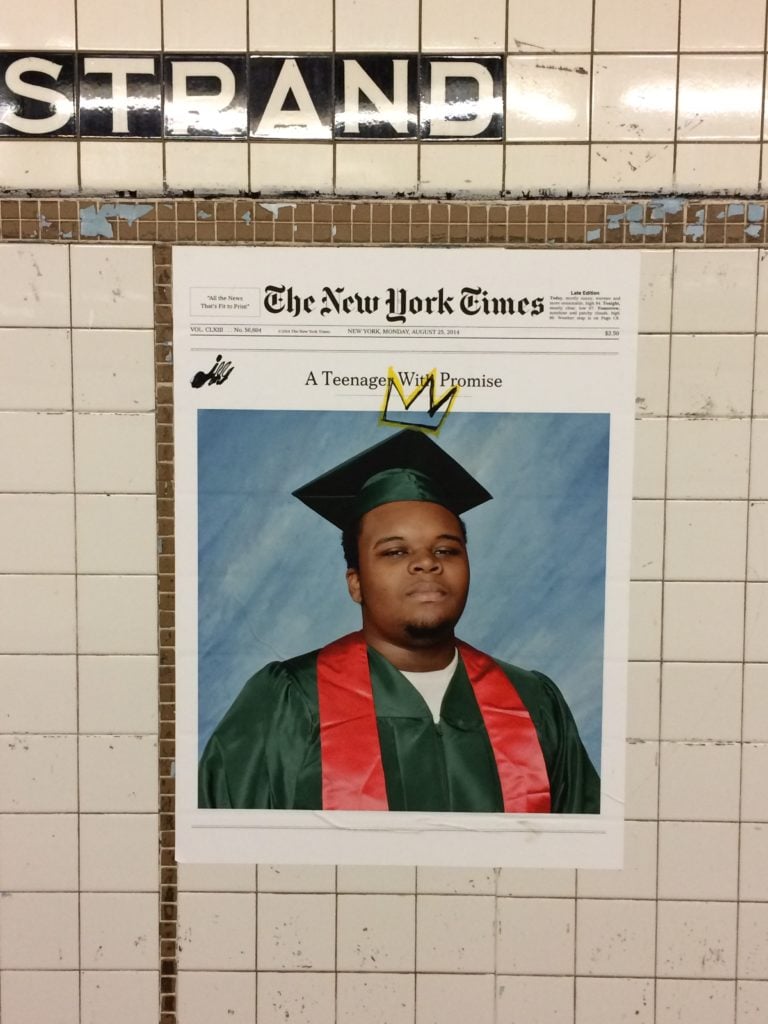People
How a Trained Journalist Is Using Public Art to Expose Media Racism
The artist's first body of work is quickly becoming a social phenomenon.

The artist's first body of work is quickly becoming a social phenomenon.

Terence Trouillot

If you live in New York, you might have spotted artist Alexandra Bell’s new public artworks in the streets recently. Her work, large-scale printouts of news articles redacted and edited by the artist, has hit a nerve, garnering attention both through social media and word of mouth. Attention in the press has gathered more slowly, which makes sense: Her posters deal forcefully with how journalism in the United States has propounded racial discrimination.
Surprisingly, this is Bell’s first foray into art making. She received her Masters in Journalism from Columbia University’s prestigious J-School in 2013, and only started building a body of work based on her occupation with the printed word more recently—a product of her indefatigable practice of reading and annotating the newspaper. The result is a series of posters and prints that are both graphically and intellectually arresting.

Mockups of A Teenager With Promise in Alexandra Bell’s studio. Image courtesy the artist.
“I started out by scratching out the titles,” Bell told me when we met at her studio in Bushwick. “And it started with the Michael Brown piece.”
Her “Michael Brown” work, A Teenager With Promise (2017), comprises two poster-size prints of the infamous New York Times articles that surfaced at the time of Brown’s funeral. The first is a profile of Darren Wilson, the officer who shot and killed the unarmed teenager, the second story about Michael Brown himself, the headline reading “A Teenager Grappling with Problems and Promise.”
Bell’s transformation of these two articles is similar to that of an editor (or graphic designer): She sifts out words, phrases, images, and entire sentences that are either superfluous or loaded with racial prejudice. The end result is a complete revision of the previous piece. Thus, Bell changed the headline to read “A Teenager With Promise” and placed an enlarged photograph of Brown in his high school cap and gown. As for the Darren Wilson text, it was almost completely redacted so that it only reads: “Officer Darren Wilson fatally shot an unarmed black teenager named Michael Brown.”

Detail of A Teenager With Promise at the Nostrand Avenue subway stop in Bedford Stuyvesant, Brooklyn. Image courtesy the artist.
An integral part of Bell’s practice involves bringing her work to public spaces instead of in a white cube, mainly in the streets and subway stations of Brooklyn (principally Bed-Stuy, Crown Heights, and Bushwick). But the posters are taken down after a few days, so an important secondary context is their circulation on social media. “People are really engaging with it [the work] like it’s a movement,” she told me.
That work about Michael Brown still generates such attention is amazing given the short attention spans of present-day media. That’s part of the point.
“At first, I was worried about the age of the article,” she said. “But a lot of the articles I’m working with are old, which now I like because I don’t want to be reactive. I’m coming at it from a journalistic background and thinking about how race and politics have been represented in newspapers historically, so the age of the article is not important.”

Artist’s annotations of New York Times article “Two Lives at Crossroads in Ferguson,”August 25, 2014. Image courtesy the artist.
Bell owes a great deal of her inspiration to Craig Flournoy’s PhD paper “Reporting the Movement in Black and White: The Emmett Till Lynching and The Montgomery Bus Boycott,” from 2003—a text that serves as a starting point to looking at the racial paradigms in journalistic narratives in United States history. “I used this dissertation as a kind of hub, research-wise,” Bell said.
Her own research not only shows the inherent prejudice against people of color in the news, but that historically there has been a concerted effort to decriminalize whiteness in the media.
According to the artist, “a lot of mistakes are about avoiding white crime.”
The idea that white criminality is masked in obscurity within the news is an important aspect of Bell’s work. This is what, ultimately, makes her work so challenging: She doesn’t simply focus on the villainization of blackness, but on the prevalence of the media’s vindication of whiteness.

Alexandra Bell, Olympic Threat, 2017. Image courtesy the artist.
Bell’s newest projects in this series make that crystal clear. For instance, she has taken on the Ryan Lochte incident during the 2016 Summer Olympics in Brazil and an article on Stanley Vernon Majors, a white man who faces murder charges for the death of Khalid Jabara, a Lebanese American.
Both articles suggest some type of prejudice, whether intentional or not. In the examples of the Lochte piece, the headline reads, “Accused of Fabricating Robbery, Swimmers Fuel Tension in Brazil,” accompanied by a picture of the runner Usain Bolt winning gold. The dichotomy between image and text is almost laughable, and infuriating. Bell’s revision places a photograph of Ryan Lochte in the pool with the headline “Rio Gas Station Footage Reveals White-American Swimmers Were Aggressors.”
With the Stanley Vernon Majors article, Bell highlights a headline that completely ignores the race of the white aggressor: “Tulsa Man, Accused of Harassing Lebanese Family, Is Charged With Murder.” Bell selected it because it shows what she believes to be a subtle form of xenophobia. “Whiteness always operates as the invisible norm—as automatically American, and the victims are always ‘The Other.’” While still a work in progress, Bell’s edits, which include changing “Tulsa Man” to “A White-American Man” and enlarging the assailant’s face, reveal her desire to assign blame and remove privilege.
https://instagram.com/p/BSkTWf2Ao-6/
While she works primarily with the New York Times, she did check to see how other publications handled the Tulsa hate crime. “The Washington Post called it a ‘peculiar fixation.’ Bullshit,” she said. “It’s racism.”
I asked Bell if she believes this type of narrative discrimination is intentional or a product of structural racism.
“I’m inclined to say that it’s ingrained in the culture,” she replied. “I don’t think people mean to be malicious, but it’s just part of the structure of journalism, probably one of the most racist institutions we have. There were something like 1,500 to 2,000 papers in circulation in United States before slavery ended. That’s a heck of a narrative jump-start. And while some of these papers were abolitionist papers, it doesn’t mean they weren’t racist. These perspectives have been shaped so consistently over time, it’s easy to have these frameworks and not really think about them.”
Update: This article has been modified to reflect a revision the artist made to one of the works. The piece that was previously titled “Four Swimmers,” has been changed to “Olympic Threat.”